Samsung SSD 840 EVO mSATA (120GB, 250GB, 500GB & 1TB) Review
by Kristian Vättö on January 9, 2014 1:35 PM ESTRandom Read/Write Speed
The four corners of SSD performance are as follows: random read, random write, sequential read and sequential write speed. Random accesses are generally small in size, while sequential accesses tend to be larger and thus we have the four Iometer tests we use in all of our reviews.
Our first test writes 4KB in a completely random pattern over an 8GB space of the drive to simulate the sort of random access that you'd see on an OS drive (even this is more stressful than a normal desktop user would see). I perform three concurrent IOs and run the test for 3 minutes. The results reported are in average MB/s over the entire time. We use both standard pseudo randomly generated data for each write as well as fully random data to show you both the maximum and minimum performance offered by SandForce based drives in these tests. The average performance of SF drives will likely be somewhere in between the two values for each drive you see in the graphs. For an understanding of why this matters, read our original SandForce article.
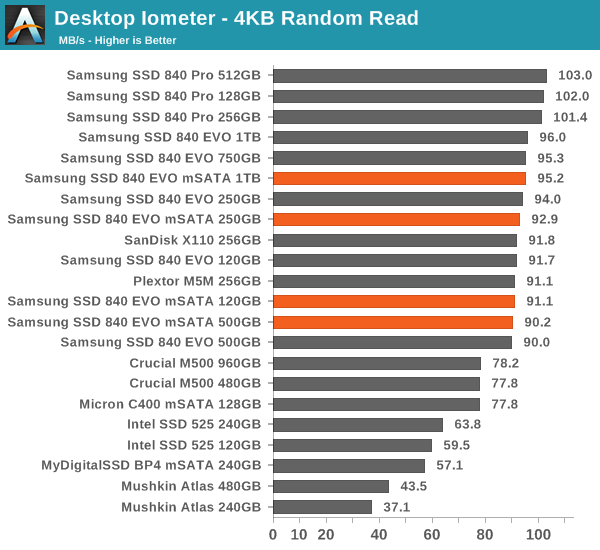
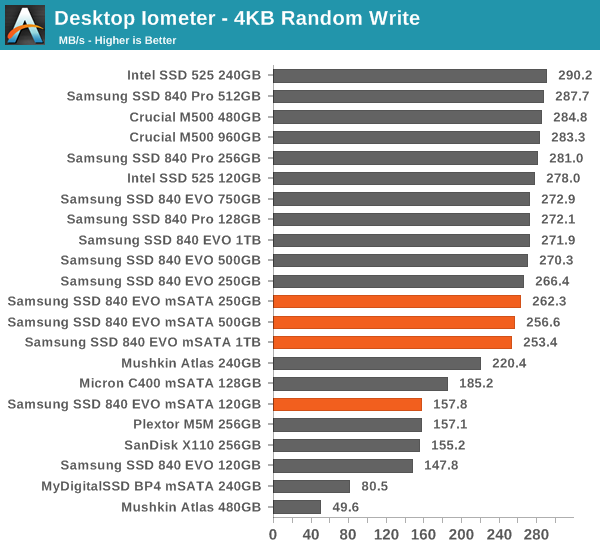
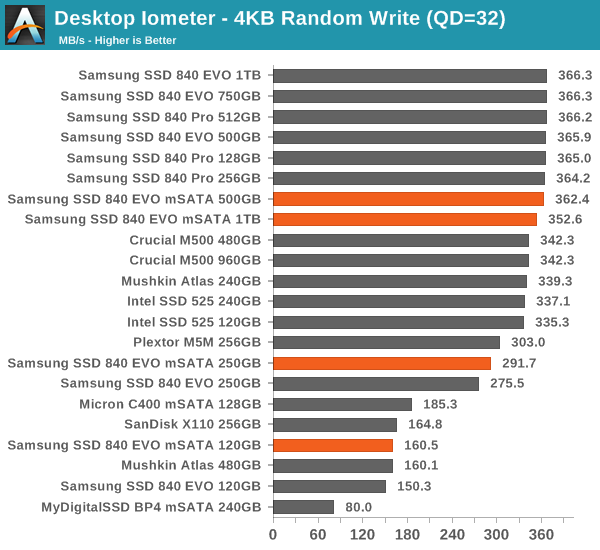
As expected, random IO performance is similar to the original EVO. There is some slight variation of course but nothing that stands out.
Sequential Read/Write Speed
To measure sequential performance I ran a 1 minute long 128KB sequential test over the entire span of the drive at a queue depth of 1. The results reported are in average MB/s over the entire test length.
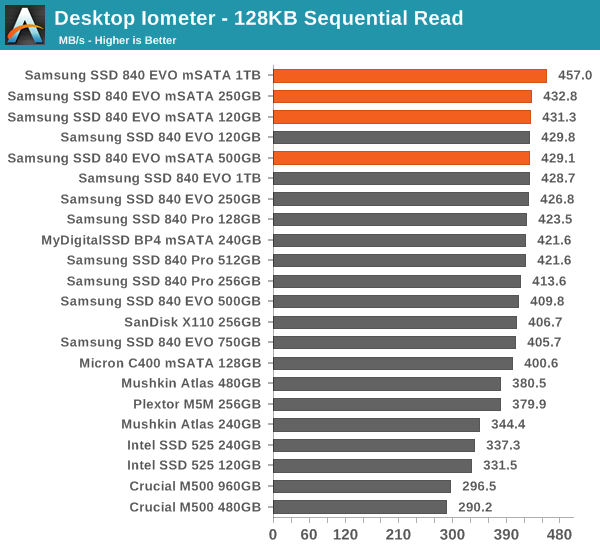
For some reason, the 1TB EVO mSATA is a few percent faster in 128KB sequential read test but falls short in the sequential write test. It's possible that the 16-die NAND has some effect on performance, which would explain the difference, but we're still dealing with rather small differences.
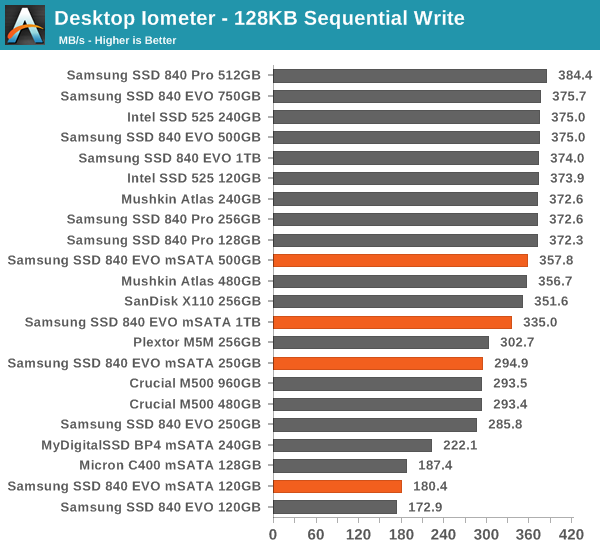
AS-SSD Incompressible Sequential Read/Write Performance
The AS-SSD sequential benchmark uses incompressible data for all of its transfers. The result is a pretty big reduction in sequential write speed on SandForce based controllers.
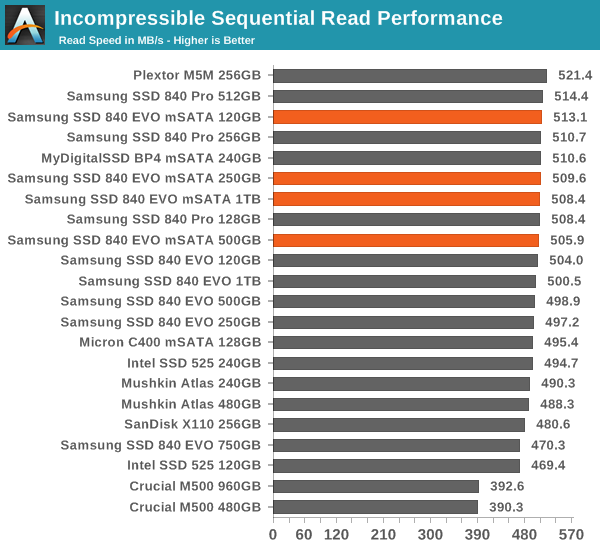











65 Comments
View All Comments
wingless - Thursday, January 9, 2014 - link
1TB in that small package?! 2014 is really the FUTURE! This will turn my laptop into a monster.Samus - Thursday, January 9, 2014 - link
What's interesting is it isn't even worth considering these models UNLESS you go with 1TB, because all the other capacities aren't nearly price competitive with the competition. Fortunately for Samsung, there is no competition at the flagship capacity, so they could charge whatever they want.Kristian Vättö - Friday, January 10, 2014 - link
Like I said, those are MSRPs, not street prices. The MSRPs of the 2.5" EVO are only $10 less but as you can see, the street prices are significantly lower.TheSlamma - Wednesday, January 15, 2014 - link
it's the presentjaydee - Thursday, January 9, 2014 - link
Hard for me to justify the 48-55% price premium of the 840 EVO over the Crucial M500 (250 GB and 500 GB versions). At some point "faster" SSD's hits diminishing returns in "real life" scenario's...fokka - Thursday, January 9, 2014 - link
"I wasn't able to find the EVO mSATA on sale anywhere yet, hence the prices in the table are the MSRPs provided by Samsung. For the record, the MSRPs for EVO mSATA are only $10 higher than 2.5" EVO's, so I fully expect the prices to end up being close to what the 2.5" EVO currently retails for."meaning: the prices will go down, once broadly available.
emn13 - Thursday, January 9, 2014 - link
On the desktop? Given the lack of power-loss protection, the 840 EVO is probably a worse choice even at comparable prices.But on mobile? Sudden power loss is less likely (though background GC complicates that picture), and the 840 EVO's lower power draw, particularly in idle, extends battery life.
I'm pretty sure I'd opt for the 840 EVO on a battery-powered device, assuming the price difference isn't too great.
nathanddrews - Thursday, January 9, 2014 - link
If it helps your decision at all, I just upgraded my wife's notebook (Lenovo Y580) from a 2.5" 250GB Samsung 840 (not pro) to an mSATA 240GB Crucial M500 (and then put the stock 750GB HDD back in) and it's phenomenal. The M500 feels snappier, but that could just be due to restoring the existing Windows image onto a clean drive. Either way, it was a great $130 upgrade.If you have a free mSATA port on your notebook, it's a no-brainer to get an SSD for it.
Solid State Brain - Thursday, January 9, 2014 - link
The trim behavior might be something introduced with one of the latest firmwares. I have a Samsung 840 250GB and I recently tried doing some steady state tests. After hammering it with writes, trim does not restore performance immediately. However with normal usage/light workloads, or keeping the drive idle, however, it will eventually (in a matter of hours) return back to the initial performance.I guess this is some kind of strategy to improve long term wear/stability/write endurance. Maybe some sustained write protection kicks in to avoid writing immediately at full speed after trimming the free space.
Solid State Brain - Thursday, January 9, 2014 - link
PS: where's the edit button to fix typos/errors, etc, when needed?? :(